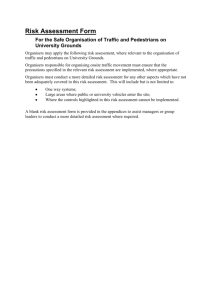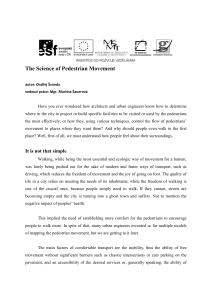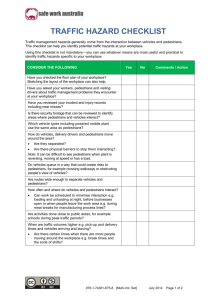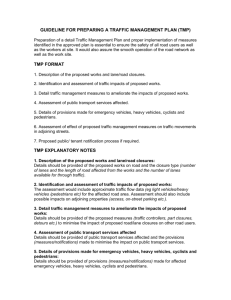Increasing the Safety of Interactions between Pedestrians and Large
advertisement
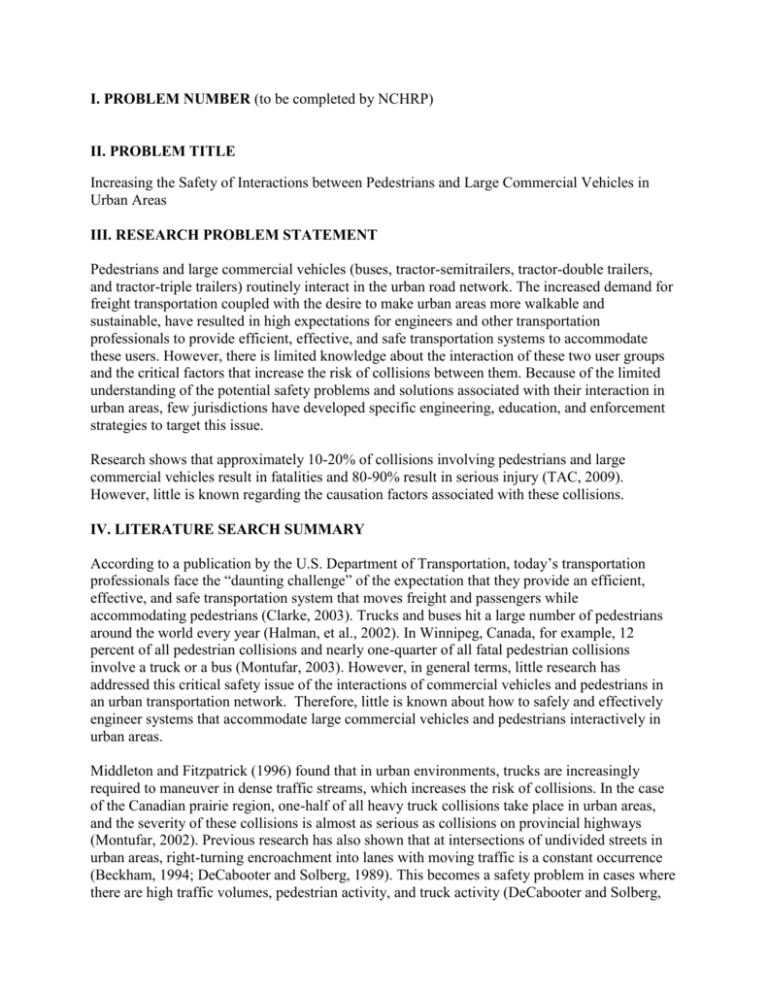
I. PROBLEM NUMBER (to be completed by NCHRP) II. PROBLEM TITLE Increasing the Safety of Interactions between Pedestrians and Large Commercial Vehicles in Urban Areas III. RESEARCH PROBLEM STATEMENT Pedestrians and large commercial vehicles (buses, tractor-semitrailers, tractor-double trailers, and tractor-triple trailers) routinely interact in the urban road network. The increased demand for freight transportation coupled with the desire to make urban areas more walkable and sustainable, have resulted in high expectations for engineers and other transportation professionals to provide efficient, effective, and safe transportation systems to accommodate these users. However, there is limited knowledge about the interaction of these two user groups and the critical factors that increase the risk of collisions between them. Because of the limited understanding of the potential safety problems and solutions associated with their interaction in urban areas, few jurisdictions have developed specific engineering, education, and enforcement strategies to target this issue. Research shows that approximately 10-20% of collisions involving pedestrians and large commercial vehicles result in fatalities and 80-90% result in serious injury (TAC, 2009). However, little is known regarding the causation factors associated with these collisions. IV. LITERATURE SEARCH SUMMARY According to a publication by the U.S. Department of Transportation, today’s transportation professionals face the “daunting challenge” of the expectation that they provide an efficient, effective, and safe transportation system that moves freight and passengers while accommodating pedestrians (Clarke, 2003). Trucks and buses hit a large number of pedestrians around the world every year (Halman, et al., 2002). In Winnipeg, Canada, for example, 12 percent of all pedestrian collisions and nearly one-quarter of all fatal pedestrian collisions involve a truck or a bus (Montufar, 2003). However, in general terms, little research has addressed this critical safety issue of the interactions of commercial vehicles and pedestrians in an urban transportation network. Therefore, little is known about how to safely and effectively engineer systems that accommodate large commercial vehicles and pedestrians interactively in urban areas. Middleton and Fitzpatrick (1996) found that in urban environments, trucks are increasingly required to maneuver in dense traffic streams, which increases the risk of collisions. In the case of the Canadian prairie region, one-half of all heavy truck collisions take place in urban areas, and the severity of these collisions is almost as serious as collisions on provincial highways (Montufar, 2002). Previous research has also shown that at intersections of undivided streets in urban areas, right-turning encroachment into lanes with moving traffic is a constant occurrence (Beckham, 1994; DeCabooter and Solberg, 1989). This becomes a safety problem in cases where there are high traffic volumes, pedestrian activity, and truck activity (DeCabooter and Solberg, 1989). In general, the literature does not reveal much about the interaction of large commercial vehicles and pedestrians in urban areas. Information exists on the safety issues of each of these as separate users of the system. However, there is a lack of comprehensive research or guidelines related to the characteristics and safety of their interactions. V. RESEARCH OBJECTIVE This project will create a best practices guide for improving the safety of interactions between commercial vehicles and pedestrians in urban settings. This will include the development of guidelines for the planning, design, and operation of facilities that accommodate large commercial vehicles and pedestrians in an interactive manner. The research will also develop planning, engineering, education, and enforcement strategies that can be used to accommodate these groups more safely in urban areas. The main objective of this research is to conduct a detailed analysis of State and/or national data bases to quantify the magnitude and characteristics of interactions and collisions between pedestrians and buses and trucks, including identifying some of the related road engineering, behavioral, and vehicle design factors. This guide will provide an enhanced knowledge base and understanding upon which urban areas can more rationally and effectively engineer systems that safely accommodate trucks, buses, and pedestrians in urban areas. The guide will also provide case study examples and/or recommendations on education and enforcement strategies that could be used to reduce the risks of such collisions. To the extent practical, the study and guide will review available literature regarding vehiclerelated factors that may impact the safety of pedestrian-commercial vehicle interactions. For example, blind spots, “crash-friendly” front ends of trucks and other types of vehicle designs that may be harmful to pedestrians when they are involved in a collision with a commercial vehicle. The study will not, however, involve any original research to test different front end designs relative to their risks to pedestrians. Research tasks are expected to include: 1. Literature review 2. Crash analysis 3. Develop guidelines/case studies 4. Final best practices guide and recommendations VI. ESTIMATE OF PROBLEM FUNDING AND RESEARCH PERIOD Recommended Funding: $400,000 Research Period: 2 years (24 months), depending on the scope of the final research project VII. URGENCY, PAYOFF POTENTIAL, AND IMPLEMENTATION This project will have both immediate and long-term payoffs. A comprehensive collision analysis will establish the urgency of the project by identifying the magnitude and severity of the problem. This will be supplemented with an environmental scan (literature review and jurisdictional survey). The literature review will document how pedestrians and large commercial vehicles interact, and will set the stage for devising a means of addressing current planning and design limitations that result in high-risk interactions of pedestrians and large trucks in urban areas. The jurisdictional review will address current experiences in selected countries around the world. Finally, this project is expected to result in initial work to devise a means to safely accommodate these two users of the transportation system. The project will produce a best practices guide for the safe accommodation of commercial vehicles and pedestrians in urban settings. This will result in potential revisions to the national guidelines in the AASHTO design manual, the 2009 MUTCD, and other national transportation engineering and planning guidelines. The changes or modifications to these manuals could have a positive impact on the safety of pedestrians throughout the country, as well as on the efficient movement of goods in urban areas. VIII. PERSON(S) DEVELOPING THE PROBLEM TRB Committee on Pedestrians (ANF 10), Subcommittee on Research Primary author: Jeannette Montufar, Chair of TRB Truck Size and Weight Committee (AT055) and member of TRB Committee on Pedestrians (ANF10). Reviewers: Ron Eck, University of West Virginia; Christopher Kinzel, HDR, Inc.; Tamara Redmon, Federal Highway Administration; Robert Schneider, UC Berkeley Safe Transportation Research & Education Center. Contact Information: Robert Schneider, TRB Pedestrian Research Subcommittee Chair, University of CaliforniaBerkeley, (510) 642-0566, rschneider@berkeley.edu. IX. PROBLEM MONITOR (to be completed by NCHRP) X. DATE AND SUBMITTED BY Date: April 26, 2011 Submitted by: TRB Committee on Pedestrians (ANF10) Selected References Beckham W. (1994), “Regional trucking issues: truck route alternatives, geometric considerations for large trucks, and regulations of Texas trucking,” prepared for North Central Texas Council of Governments. Clarke A. (2003), "Bikeways and Pathways," Public Roads, Washington, D.C. Vol. 67 No. 1, July/August, pp 26-31. DeCabooter P.H. and Solberg C.E. (1989), “Operational considerations relating to long trucks in urban areas,” Transportation Research Record 1249, Washington, D.C. Halman S.I., Chipman M., Parkin P.C., and Wright J.C. (2002), "Are seat belt restraints as effective in school age children as adults?: a prospective crash study," British Medical Journal, Volume 324, pp 1123-1125. Middleton D. and Fitzpatrick K. (1996), "Truck accident countermeasures for urban freeways," ITE Journal, November, pp 44-51. Montufar, J. (2003), "Pedestrian collision profile for Winnipeg," prepared by Montufar & Associates for Manitoba Public Insurance, Winnipeg, Manitoba. Montufar J. (2002), "Applying GIS-T for heavy truck safety analysis," ITE Journal, January, Vol. 72, No. 1, pp. 44-48. TAC (2009), “Study on the Safe Accommodation of Vulnerable Road Users and Commercial Motor Vehicles in Urban Areas”

